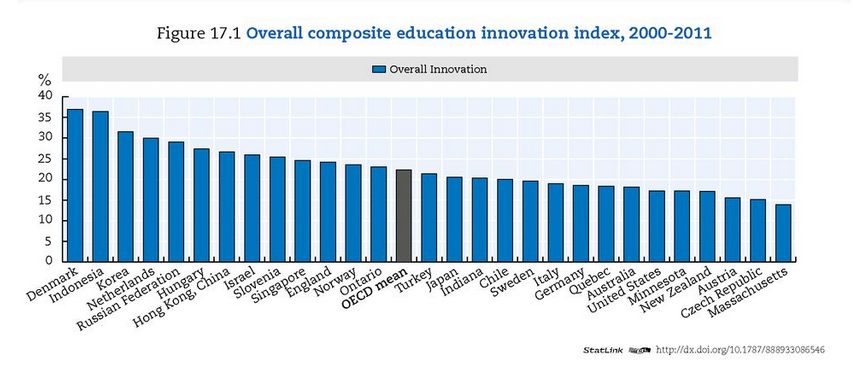Innovation in U.S. Classrooms: An international perspective
At the end of last month, the Organization for Economic Cooperation and Development (OECD) published a report examining innovative practices in classrooms around the world. The report, titled, “Measuring Innovation in Education,” examines innovative practices in schools and classrooms from an international perspective. (The report also features a Foreword by Andreas Schleicher, a member of the Rodel Foundation’s International Advisory Group.
Innovation in any sector is a crucial driver towards improvement. Particularly in this age of international competitiveness, innovation can be a distinguishing factor, helping a city, state, or country become or stay competitive with peers. “Measuring Innovation in Education” uses data from surveys of educators, students, employees, and employers around the world. The study authors used the survey data to create indices to measure both the amount of innovation occurring in classrooms around the world as well as the impact that innovation has had on student performance. Overall, when compared to countries around the world, the United States ranks near the bottom of the group studied in terms of its innovation in schools and classrooms.
It is important to note, however, that just because a country ranks high on the OECD education innovation index does not necessarily translate into a higher-quality education system. To quote the study’s lead author Stephan Vincent-Lancrin, “Innovation is a means to an end. We need to think of it not as an indicator of performance itself, but something that will translate into better educational outcomes” (Molnar). So, there is room for the United States to increase the levels of innovative practices in schools and classrooms with the ultimate goal of improving student performance and student outcomes.
The report also noted the top five areas of innovation in schools and classrooms for each country included in the study. The United States was ranked high for its school-level innovations in the following areas:
1. Use of assessment data for monitoring school progress
2. Use of assessment data for use with district/national performance
3. Achievement data to inform parent on student performance
4. Changes in teacher evaluation practices at secondary level
5. Parental involvement on school committees
The United States was ranked high for its classroom-level innovations in the following areas:
1. Observe and describe in science
2. Use of individualized instruction in reading
3. Explain answers in math
4. Students relating math and science concepts to their lives
5. Text interpretation
Innovative practices like these and others will continue to be powerful methods of continuously improving not just our nation’s education system, but our nation’s overall global competitiveness. As innovative practices prove successful, they have the potential to affect the entire system and lead to stronger student results in the long term.
What are some innovative practices you have seen at work in Delaware’s schools and classrooms?
